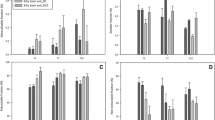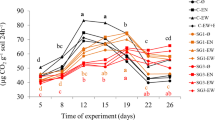Abstract
Organic matter (OM) decomposition and soil fauna feeding activity were integrated as functional endpoints into ecotoxicological tests with intact-soil-core Terrestrial Model Ecosystems (TMEs). Cellulose filter paper served as standardized OM and was either inserted into the top soil or placed on the soil surface for a period of up to 16 weeks. Faunal feeding activity was assessed by the bait-lamina method. The fungicide carbendazim, applied at six dosages ranging from 0.36 kg/ha to 87.5 kg a.i./ha, served as a model chemical. To validate the results from the TME test, a field study was run in parallel. In TMEs the cellulose paper inserted into the soil was decomposed faster than under field conditions. The carbendazim-induced effects on OM decomposition in TMEs and in the field were comparable and followed a clear dose–response relationship. The calculated EC50 values after 8 weeks of incubation were 9.5, 7.1 and 2.1 kg carbendazim/ha for grassland TMEs, grassland field and arable TMEs, respectively. The feeding activity of the soil fauna showed a large variability. The EC50 values for the effect of carbendazim on bait-lamina consumption ranged between 2.0 and 56 kg a.i./ha. Effects on decomposition were correlated with effects on enchytraeids and earthworms but not with effects on bait-lamina consumption.
Similar content being viewed by others

References
Bengtsson, G., Berden, M. and Rundgren, S. (1988). Influence of soil animals and metals on decomposition processes: a microcosm experiment. J. Environ. Qual. 17, 113-9.
Beyer, L., Blume, H.-P., Friedrich, F. and Vogt, J. (1992). Der durchschnittliche, langfristige Abbau vergrabener Zellulose in typischen Acker-und Waldbö den der Norddeutschen Tiefebene. Pedobiologia 36, 11-20.
Bienkowski, P. (1990). Cellulose decomposition as bioenergetic indicator of soil degradation. Pol. Ecol. Stud. 16, 235-44.
Bjørnlund, L., Ekelund, F., Christensen, S., Jacobsen, C.S., Krogh, P.H. and Johnsen, K. (2000). Interactions between saprotrophic fungi, bacteria and protozoa on decomposing wheat roots in soil influenced by the fungicide fenpropimorph (Corbel®): a field study. Soil Biol. Biochem. 32, 967-75.
Cadisch, G. and Giller, K.E. (1997). Driven by Nature. Plant Litter Quality and Decomposition. CAB International, Wallingford, UK, 409 pp.
Chen, S.-K. and Edwards, C.A. (2001). A microcosm approach to assess the effects of fungicides on soil ecological processes and plant growth: comparisons of two soil types. Soil Biol. Biochem. 33, 1981-91.
Cortet, J. and Poinsot-Balaguer, N. (2000). Impact of phytopharmaceutical products on soil microarthropods in an irrigated maize field: the use of the litter bag method. Can. J. Soil Sci. 80, 237-49.
Eijsackers, H. and Zehnder, A.J.B. (1990). Litter decomposition: a Russian matriochka doll. Biogeochemistry 11, 153-74.
Federschmidt, A. and Römbke, J. (1994). Erfahrungen mit dem Köderstreifen-Test auf zwei fungizidbelasteten Standorten. Braunschw. Naturkdl. Schr. 4, 675-80.
Förster, B., Eder, M., Morgan, E. and Knacker, T. (1996). A microcosm study of the effects of chemical stress, earthworms and microorganisms and their interaction upon litter decomposition. Eur. J. Soil Biol. 32, 25-33.
Geissen, V. and Brümmer, G. (1999). Decomposition rates and feeding activities of soil fauna in deciduous forest soils in relation to soil chemical parameters following liming and fertilization. Biol. Fertil. Soils 29, 335-42.
Gillett, J.W. and Witt, J.M. (1980). Chemical evaluation: projected application of terrestrial microcosm technology. In J.P. Giesy Jr. (ed). Microcosms in Ecological Research, Technical Information Center US Department of Energy; Springfield, Virginia, USA, pp. 1008-33.
Gulley, D.D., Boelter, A.M. and Bergman, H.L. (1991). TOXSTAT. (Release 3.3. ed). Laramie: Fish Physiology and Toxicology Laboratory, Department of Zoology and Physiology, University of Wyoming.
Haanstra, L., Doelman, P. and Oude Voshaar, J.H. (1985). The use of sigmoidal dose response curves in soil ecotoxicological research. Plant Soil 84, 293-7.
Heisler, C. (1994). Vergleich zwischen der biotischen Aktivität nach Von Törne und der Collembolen-Zahl verdichteter Ackerböden. Zool. Beitr. N.F. 35, 19-26.
Heisler, C. (1998). Beeinflussung der biologischen Aktivität und Fruchtfolge. Agribiol. Res. 51, 289-97.
Heisler, C. and Brunotte, J. (1998). Beurteilung der Bodenbearbeitung mit Pflug und der konservierenden Bodenbearbeitung hinsichtlich der biologischen Aktivität mittels des Köderstreifen-Tests nach Von Törne sowie der Populationsdichten von Collembolen und Raubmilben. Landbauforschung Völkenrode 2, 78-85.
Helling, B., Pfeiff, G. and Larink, O. (1998). A comparison of feeding activity of collembolan and enchytraeid in laboratory studies using the bait-lamina test. Appl. Soil Ecol. 7, 207-12.
Irmler, U. (1998). Spatial heterogeneity of biotic activity in the soil of a beech wood and consequences for the application of the bait-lamina-test. Pedobiologia 42, 102-8.
Kampmann, T. (1994). Entwicklung eines standardisierten Labortests mit Köderstreifen fürökotoxikologische Prüfungen: Erste Vorversuche. Braunschw. Naturkdl. Schr. 4, 681-6.
Knacker, T., Van Gestel, C.A.M., Jones, S.E., Soares, A.M.V.M., Schallnaß, H.-J., Förster, B. and Edwards, C.A. (2004). Ring-testing and field-validation of a Terrestrial Model Ecosystem (TME)-an instrument for testing potentially harmful substances: conceptual approach and study design. Ecotoxicology 13, 9-27.
Koolhaas, J.E., Van Gestel, C.A.M., Römbke, J., Soares, A.M.V.M. and Jones, S.E. (2004). Ring-testing and fieldvalidation of a Terrestrial Model Ecosystem (TME)-an instrument for testing potentially harmful substances: effects of the model chemical carbendazim on soil microarthropod communities. Ecotoxicology 13, 75-88.
Kratz, W. (1998). The bait-lamina test-general aspects, applications and perspectives. Environ. Sci. Pollut. Res. 5, 94-6.
Krogh, P.H. (1991). Perturbation of the soil micro arthropod community with the pesticides benomyl and isofenphos. Pedobiologia 35, 71-88.
Kula, C. and Römbke, J. (1998). Evaluation of soil ecotoxicity tests with functional endpoints for the risk assessment of plant protection products-state-of-the-art. Environ. Sci. Pollut. Res. 5, 55-60.
Kurka, A.-M., Starr, M., Heikinheimo, M. and Salkinoja-Salonen, M. (2000). Decomposition of cellulose strips in relation to climate, litterfall nitrogen, phosphorus and C/N ratio in natural boreal forests. Plant and Soil 219, 91-101.
Kurka, A.-M., Starr, M., Karsisto, M. and Salkinoja-Salonen, M. (2001). Relationship between decomposition of cellulose strips and chemical properties of humus layer in natural boreal forests. Plant and Soil 229, 137-46.
Larink, O. (1994a). Der Köderstreifen-Test in der Pflanzenschutzmittel-Prüfung. Braunschw. naturkdl. Schr. 4, 671-4.
Larink, O. (1994b). Bait lamina as a tool for testing feeding activity of animals in contaminated soils. In Donker, M.H, Eijsackers, H. and Heimbach, F. (eds). Ecotoxicology of Soil Organisms, Boca Raton, Florida, USA: Lewis Publishers, pp. 339-45.
Larink, O. and Kratz, W. (1994). Köderstreifen-workshop in Braunschweig-ein Resümee. Braunsch. naturkdl. Schr. 4, 647-51.
Martikainen, E., Haimi, J. and Ahtiainen, J. (1998). Effects of dimethoate and benomyl on soil organisms and soil processes-a microcosm study. Appl. Soil Ecol. 9, 381-7.
Moser, T., van Gestel, C.A.M., Jones, S.E., Koolhaas, J.E., Rodriguez, J.M.L. and Römbke, J. (2004a). Ring-testing and field-validation of a Terrestrial Model Ecosystem (TME)-an instrument for testing potentially harmful substances: effects of carbendazim on enchytraeids. Ecotoxicology 13, 89-103.
Moser, T., Schallnaß, H.-J., Jones, S.E., Van Gestel, C.A.M., Koolhaas, J.E., Rodrigues, J.M.L. and Römbke, J. (2004b). Ring-testing and field-validation of a Terrestrial Model Ecosystem (TME)-an instrument for testing potentially harmful substances: effects of carbendazim on nematodes. Ecotoxicology 13, 61-74.
Römbke, J., van Gestel, C.A.M., Jones, S.E., Koolhaas, J.E., Rodrigues, J.M.L. and Moser T. (2004b). Ring-testing and field-validation of a Terrestrial Model Ecosystem (TME)-an instrument for testing potentially harmful substances: effects of carbendazim on earthworms. Ecotoxicology 13, 105-118.
Müller, G., Broll, G. and Tarnocai, C. (1999). Biological activity as influenced by microtopography in a cryosolic soil, Baffin Island, Canada. Permafrost Periglacial Processes 10, 279-88.
Paulus, R., Römbke, J. and Beck, L. (1999). A comparison of the litterbag-, minicontainer-and bait-lamina-methods in an ecotoxicological field experiment with diflubenzuron and btk. Pedobiologia 43, 120-33.
Ruf, A., Römbke, J., Paulus, R. and Beck, L. (1997). Die Wirkung von Dimilin auf Individuen und Populationen von Bodentieren und die biologische Aktivität des Bodens eines Laubwaldes. Mitt. Dtsch. Ges. Allg. Angew. Ent. 11, 211-5.
Salminen, J. and Haimi, J. (1997). Effects of pentachlorophenol on soil organisms and decomposition in forest soil. J. Appl. Ecol. 34, 101-10.
Schick, H. (1999). Der Celluloseabbautest-Ein funktionales Testverfahren zur Beurteilung der Lebensraumfunktion des Bodens für Bodenorganismen. Braunschw. naturkdl. Schr. 5, 925-34.
Schönborn, W. and Dumpert, K. (1990). Effects of pentachloro phenol and 2,4,5-trichlorophenoxyacetic acid on the microflora of the soil in a beech wood. Biol. Fertil. Soils 9, 292-300.
Schröder, D. and Gewehr, H. (1977). Stroh-und Zelluloseabbau in verschiedenen Bodentypen. Z. Pflanzenernähr. Bodenk. 140, 273-84.
Sheppard, S.C. (1997). Toxicity testing using microcosms. In: Tarradellas, J., Bitton, G. and Rossel, D. (eds). Soil Ecotoxicology, Lewis Publishers, Boca Raton, pp. 345-73.
Sokal, R.R. and Rohlf, F.J. (1969). Biometry. San Francisco: W.H. Freeman.
Sorensen, L.H. (1983). Size and persistence of the microbial biomass formed during the humification of glucose, hemicellulose, cellulose, and straw in soils containing different amounts of clay. Plant and Soil 75, 121-30.
Sousa, J.P., Rodrigues, J.M.L., Loureiro, S., Soares, A.M.V.M., Jones, S.E., Förster, B. and van Gestel, C.A.M. (2004). Ring-testing and field-validation of a Terrestrial Model Ecosystem (TME)-an instrument for testing potentially harmful substances: effects of carbendazim on soil microbial parameters. Ecotoxicology 13, 43-60.
Sowerby, A., Blum, H., Gray, T. and Ball, A. (2000). The decomposition of Lolium perenne in soils exposed to elevated CO2: comparisons of mass loss of litter with soil respiration and soil microbial biomass. Soil Biol. Biochem. 32, 1359-66.
Swift, M.J., Heal, O.W. and Anderson, J.M. (1979). Decomposition in Terrestrial Ecosystems. Studies in Ecology, Volume 5. Blackwell Scientific Publications, Oxford, London, Edinburgh, Melbourne, 372 pp.
Unger, H. (1960). Der Zellulosetest, eine Methode zur Ermittlung der zellulolytischen Aktivität des Bodens in Feldversuchen. Zeitschr. Pflanzenernähr. Düng. Bodenkunde 91, 44-52.
Van Wensem, J. (1989). A terrestrial micro-ecosystem for measuring effects of pollutants on isopod-mediated litter decomposition. Hydrobiologia 188/189, 507-16.
Velthorst, E.J. (1993). Manual for chemical water analysis. Department of Soil Science and Geology, Agricultural University, Wageningen, The Netherlands.
Vink, K. and Van Straalen, N.M. (1999). Effects of benomyl and diazinon on isopod-mediated leaf litter decomposition in microcosms. Pedobiologia 43, 345-59.
Von Törne, E. (1990a). Assessing feeding activities of soil-living animals. I. Bait-lamina-test. Pedobiologia 34, 89-101.
Von Törne, E. (1990b). Schätzungen von Fressaktivitäten bodenlebender Tiere. II. Mini-Köder-Tests. Pedobiologia 34, 269-79.
WHO (1993). Carbendazim. Environmental Health Criteria 149. Published under the joint sponsorship of the United Nations Environment Programme, the International Labour Organisation, and the World Health Organisation, Geneva, Switzerland, pp. 1-125.
Author information
Authors and Affiliations
Corresponding author
Rights and permissions
About this article
Cite this article
Förster, B., Van Gestel, C.A., Koolhaas, J.E. et al. Ring-testing and Field-validation of a Terrestrial Model Ecosystem(TME) – An Instrument for Testing Potentially Harmful Substances: Effects of Carbendazim on Organic Matter Breakdown and Soil Fauna Feeding Activity. Ecotoxicology 13, 129–141 (2004). https://doi.org/10.1023/B:ECTX.0000012410.99020.97
Issue Date:
DOI: https://doi.org/10.1023/B:ECTX.0000012410.99020.97



